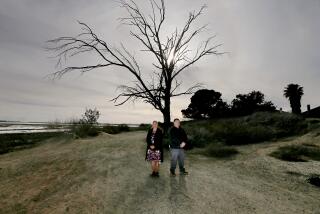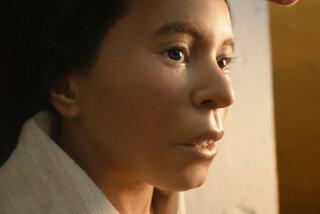Topics / ART : Mural to Honor a Long-Ago Hero : Planned artwork at San Dimas Civic Center will depict legendary Native American, Juana Maria. She lived alone on an island for 18 years.
- Share via
A depiction of the Native American tribe that once inhabited the area that is now San Dimas will soon grace its Civic Center in a mural commissioned by the San Dimas Festival of Western Arts.
The mural in sculptural relief will depict the life of Juana Maria, the lone woman of St. Nicolas Island. The legendary Tongva woman survived 18 years of solitude after she was abandoned on the island, and inspired the children’s novel “Island of the Blue Dolphins.”
To members of the Tongva tribe, the mural project is a long-overdue tribute to their culture, which flourished in the Los Angeles Basin and Channel Islands for 7,000 years before the arrival of Europeans. The Spanish missionaries called the tribe the Gabrielinos.
“It’s an acknowledgment of our people,” said Cindi Alvitre, director of the Ti’at Society, a local Native American group named for the traditional Tongva canoe. “It’s a coming out of our history.”
The mural will be 45 feet long by 7 feet high, and will depict scenes from Juana Maria’s story and vignettes of everyday Tongva life, said Ken Sheffer, director of the festival’s public arts committee. The committee will select an artist through a national competition and is seeking submissions for the $75,000 project.
An exhibit of Tongva culture and artifacts will accompany the mural at San Dimas City Hall, including a 27-foot redwood-plank canoe built by the Ti’at Society and items gathered at archeological digs in the area.
The Tongva people lived in more than 100 villages scattered from the Channel Islands to Riverside, including one in the San Dimas-La Verne area, Alvitre said. They developed a regional trade system and an elaborate maritime culture. After hostilities with Russian traders decimated the population of St. Nicolas Island in the 1830s, missionaries from the San Gabriel Mission sailed over to relocate the remaining two dozen tribe members, Alvitre said. But one woman, known now as Juana Maria, leaped off the boat to search for her child, who had been left behind. Stormy weather forced the ship to leave without them; the child is believed to have died a short time later.
Presumed dead, Juana Maria remained alone on the island for 18 years. Fishermen sailing near the island eventually caught glimpses of her and realized she was still alive. She was rescued in 1853 and taken to Santa Barbara, where she died less than two months later, Alvitre said.
The story formed the basis for Scott O’Dell’s 1960 novel, “Island of the Blue Dolphins,” and Juana Maria became a heroic figure to her tribe.
“She maintained her pride, her generosity and her integrity,” Alvitre said. “She just reflects so much of the tragedy and the pride and the values of our people.”
When the public arts committee consulted with Tongva tribal members to ask what they would like to see depicted in the mural, Sheffer said, Juana Maria was the almost unanimous choice.
“To the Tongva, she symbolizes the kind of courage they need in themselves, in their struggle to keep their culture alive,” he said.
More to Read
The biggest entertainment stories
Get our big stories about Hollywood, film, television, music, arts, culture and more right in your inbox as soon as they publish.
You may occasionally receive promotional content from the Los Angeles Times.










